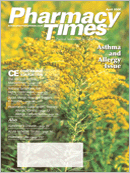Publication
Article
Pharmacy Times
Infection Control: Focus on Prevention
Author(s):
Despite the advent of newerantibiotics and advancementsin technology, nosocomial infectionsremain a major problem in today'shealth care system. The Centers forDisease Control and Prevention (CDC)estimates that approximately 2 millionhospitalized patients each year acquireinfections that were not related to thecondition for which they were admitted.1In general, these types of health care-associated infections can be reduced byappropriate infection control, such asgood hand washing, the use of protectivebarriers, and contact isolation protocols.2,3
The Joint Commission on Accreditationof Healthcare Organizations(JCAHO) published new standards ofinfection control in 2005, citing increasingantimicrobial resistance and emergingpathogens as a major concern. TheJCAHO standards expect institutions toimplement infection-prevention and controlprocesses, to identify areas of risk fortransmission of infection, to utilize surveillancedata effectively, and to educatepractitioners to comply with their institution'sinfection-control procedures.2
Antimicrobial Resistance
Hospitals worldwide are faced withthe increasingly rapid emergence andspread of antibiotic-resistant bacteria.Both resistant gram-positive and gramnegativebacteria are reported to beimportant pathogens of hospital-acquiredinfections. Among gram-positivebacteria, methicillin-resistant Staphylococcusaureus (MRSA) and vancomycin-resistant Enterococci (VRE) arecommon and problematic infections inthe hospital setting. MRSA infectionshave increased dramatically within hospitalsand the community; however,ample treatment options have becomeavailable in recent years.4 VRE infectionshave increased among intensive carepatients over the last several years—perhapsdue to high antimicrobial usage inthis setting, which has resulted inincreased hospital morbidity rates fromthis type of bacteria.5
Multidrug-resistant gram-negative infectionsare on the rise, including strainsof Pseudomonas, Acinetobacter, andextended-spectrum beta-lactamasesKlebsiella and Escherichia coli. Minimaltreatment options exist for these resistantpathogens, forcing clinicians to utilizeolder antimicrobials associated with hightoxicity. Clostridium difficile is anotherhighly transferable pathogen; most institutionsrequire infected patients toremain in isolation. Fortunately, there aremethods to prevent the spread of manyof these infections.4
Preventive Measures
Hand Hygiene
Since the early 1800s,good hand hygiene hasbeen recognized as thesingle best method to preventthe spreadof nosocomialinfections. 6Despite thisfact, manyhealth care providers are not compliantwith hand-washing policies.7 The authorsof many studies conducted on handwashingcompliance report that healthcare practitioners comply with appropriatehand hygiene only 25% to 50% of thetime.8,9 In October 2002, the CDC releasedthe "Guideline for Hand Hygiene inHealth-Care Settings," which recommendswashing with soap and waterwhen hands are visibly dirty. If hands arenot visibly soiled, practitioners shoulduse an alcohol-based or other antisepticrub—chlorhexidine gluconate, iodophors,parachlorometaxylenol, or triclosan.6,10 Of note, none of the antiseptichand rubs are reliably active againstspore-forming bacteria such as C difficileand Bacillus anthracis. Health care practitionersmust remember to wash theirhands thoroughly with soap and water tohelp physically remove these sporesfrom their hands.8,10 Regardless of themethod, hands must be properly decontaminatedimmediately before and aftereach direct patient contact.
Personal Protective Equipment (PPE)
In addition to hand washing, the useof gloves, gowns, and masks has beenshown to reduce the transmission ofspecific pathogens.8 The selection ofPPE should be based on an assessmentof the risk for contamination ofthe health care worker's clothing andskin by the patient's blood, body fluids,or other secretions. Gloves should beworn for all invasive procedures andfor general contact with areas of thepatient that are normally sterile. Glovesmust be changed between patientsand disposed of as clinical waste. Typesof gloves that may be worn includevinyl, nitrile, or latex, depending on thepatient's allergies. Gloves do not substitutefor good hand-hygiene practices,because the hands must bedecontaminated upon removalof the gloves to ensure no transmissionof infections.11
Full-body gowns should beworn when there is a risk ofextensive splashing of blood orother potentially infectious materialonto the health care practitioner.Masks and protectiveeyewear should be worn if thereare likely to be splashes orsprays of infectious materialsinto the health care worker'sface during procedures or otherpatient activities. Of note, surgicalmasks do not provide adequateprotection against hazardousairborne diseases. Incases of known or suspectedtuberculosis or infection withrubeola and varicella viruses, respiratorsor N95 masks should beworn prior to entering a patient'sroom. It is recommended thatthese materials be readily availableoutside a patient's room toencourage compliance with infection-control standards.9
Isolation/ContactPrecautions
Contact precautions are designedto reduce the risk oftransmission of a known organismby limiting direct or indirectcontact. All persons entering anisolation room must put ongowns, gloves, and/or masksprior to entering, even if theyare not expected to come incontact with infectious material.Although it has been arguedthat gown use is ineffective as abarrier for infections, requireduse may reduce bacterialspread by increasing awarenessof infection-control measuresfor those patients on isolationprecautions.9 Infections causedby the following bacteria arecommonly put on contact precautions:VRE, MRSA, C difficile,and multidrug-resistant gramnegativebacteria.12
Antibiotic Restrictions/Rotations
The overuse of broad-spectrumantibiotics is a problem thatcan increase antibiotic resistancein many hospitals. Various strategiesfor improving antibiotic utilizationhave been proposed,because inadequate antibiotictreatment has been associatedwith increased hospital mortalityrates, prolonged hospitalization,and increased overall health carecosts.3 At a minimum, cliniciansshould make sure that antibioticsare dosed appropriately, at thecorrect frequency, and that theyprovide adequate coverage forsuspected organisms. Someinstitutions have employed antimicrobialformularies to restrictantibiotic drug choices, and othershave attempted a system ofantibiotic-class rotation for reducingthe emergence of antimicrobialresistance. Both methodsappear to be effective for limitedperiods in closed environmentssuch as intensive care units.6,13
In conclusion, proper infectioncontrol needs to include educationof patients, their caretakers,and health care personnel aboutgood preventive measures.14These measures should includeappropriate hand hygiene, the useof PPE or isolation when indicated,and judicious use of antibiotics.Hospitals should incorporateongoing measurement of performanceand adherence to infection-control procedures throughsurveillance systems, with healthcare providers held accountablefor noncompliance with standards.Only then can cliniciansattempt to decrease the incidenceof health care-associatedinfections.
Dr. Cross is a transplant clinical pharmacistwith Piedmont Hospital inAtlanta, Ga.
For a list of references, send astamped, self-addressed envelope to:References Department, Attn.A. Stahl, Pharmacy Times,241 Forsgate Drive, Jamesburg, NJ08831; or send an e-mail request to:astahl@ascendmedia.com.







